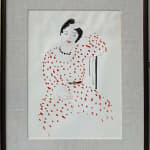Elmyr de Hory Hungarian, 1906-1976
Size with frame 35 x 27 1/2 ins
The life of Elmyr de Hory is itself a work of art—everything about him was a grand gesture of artifice. Moving to the United States after World War II, de Hory portrayed himself as a dispossessed Hungarian aristocrat selling off artworks from his collection. Befriending the rich and famous, de Hory was both enigmatic and charming. Yet, behind his façade, de Hory was a frustrated artist struggling to maintain a standard of living he craved but could not afford. His post-impressionist style of painting appeared passé compared to new styles like abstract expressionism. After several failed attempts to ignite his own career, de Hory focused on his talent as a forger.
De Hory’s skill at deception did not make him immune to treachery, most notably during his partnership with Fernand Legros, who sold a steady supply of de Hory’s forgeries on five continents over a period of nine years. Their profitable and prolific collaboration came to a tumultuous end in 1967 when Legros sold over 40 of de Hory’s bogus masterpieces to Texas oil millionaire Algur Meadows. After discovering the fraud, the ensuing scandal unmasked de Hory as the artist behind the works. With Legros’ aid, de Hory likely inserted more than 1,000 forgeries into the art market during his 30-year career. Many of these works have not been exposed and continue to reside in museums and private collections today. {Int'l Art & Artists]
Join our mailing list
McEwan Gallery Newsletter
* denotes required fields
We will process the personal data you have supplied in accordance with our privacy policy (available on request). You can unsubscribe or change your preferences at any time by clicking the link in our emails.



